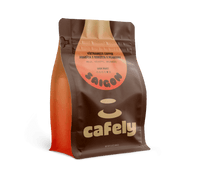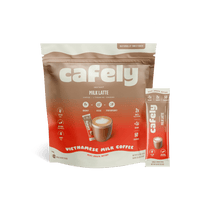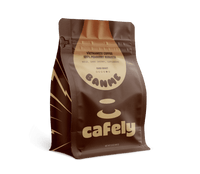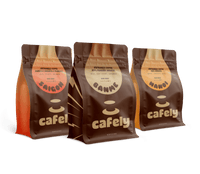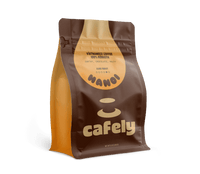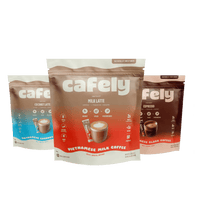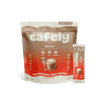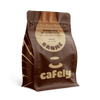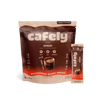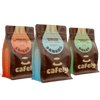Butter coffee combines high-quality coffee with grass-fed butter. This combination provides prolonged energy for those following a keto or low-carb, high-fat diet.
The caffeine in the coffee provides an instant boost, while the fat in the butter offers sustained energy throughout the day.
Check out our recent article on the full list of butter coffee benefits!
Making a cup of butter coffee can be as simple as adding a spoon or two of butter to your morning brew.
However, the recipe in this guide produces a pleasant, creamier beverage that's more comparable to a typical latte or cappuccino.
What You Need to Make Butter Coffee

Butter coffee doesn't require much in the way of ingredients, but you will need a few pieces of equipment if you want a creamy brew with latte-like qualities.
Here's what you need to make butter coffee:
Ingredients
- Coffee — Opt for a high-quality, whole-bean coffee.
- Water — Use fresh, filtered water to brew your coffee.
- Butter — Opt for grass-fed organic butter for the best nutrient profile.
Equipment
- Coffee Maker — You can make butter coffee with any kind of brewer. We recommend using a French press, pour-over, or drip coffee maker for the best results.
- Coffee Grinder — The best butter coffee is made with whole beans. You'll need a burr or blade coffee grinder to grind the beans just before brewing.
- Blender — A blender is used to whip the butter and coffee to create a velvety, latte-like texture and taste.
- Coffee Measure — Use a coffee scoop or weighing scale to measure the correct amount of grounds.
- Tablespoon Measure — Use a tablespoon measure (not just a spoon out of your cutlery drawer) to accurately measure the butter. This is essential if you want to monitor your calorie and fat intake.
Coffee Recommendations
The type of coffee you use to make butter coffee isn't particularly important. However, it should be high-quality, mold-free, organic, and freshly ground. Whether you choose arabica, robusta, or a blend of both beans is up to you.
Each bean type has different qualities that you may or may not want in your cup of butter coffee.
Here are some recommendations and why you may want to select one of them:
- 100% Arabica Coffee — Arabica beans, such as Cafely DaLat, produce a naturally sweet, smooth brew with a mild caffeine hit.
- 100% Robusta Coffee — Robusta beans, such as Cafely BanMe or HaNoi, produce a strong, dark, slightly bitter brew with around twice the caffeine content of arabica.
- Coffee Blends — A blend of robusta and arabica, such as Saigon OG, offers a balance of both beans. Expect smooth, sweet flavors with intense woody notes and a strong caffeine hit.
How to Make Butter Coffee: Step-by-Step
Making butter coffee can be as simple as brewing a cup of your favorite coffee and adding a scoop of butter. However, measuring the ingredients accurately and combining them in a blender makes for a much creamier, consistent beverage.
Here's how to make butter coffee step-by-step:
1. Measure & Grind the Coffee

First, measure and grind your coffee. The exact amount of coffee you'll need depends on the brewing method used. If you're using a French press, pour-over, or drip coffee maker, you'll need somewhere between 10 and 20 grams per 8 oz (240 mL) serving.
The consistency of the grind can also differ depending on the brewing technique used. For immersion brewing (like the methods mentioned above), a medium to coarse grind is required.
2. Brew the Coffee

Once you've ground the coffee, brew an 8-oz (240 mL) serving using your chosen brewing method.
3. Combine the Ingredients

Add two tablespoons (30 mL) of high-quality grass-fed butter to a blender. Then, add your cup of hot, freshly brewed coffee.
4. Blend the Ingredients

Seal the lid of your blender and blend on high for 20 to 30 seconds. The resulting liquid should have a creamy color and velvety texture with a light foam on the surface.
5. Pour & Serve

Once thoroughly combined, immediately pour the brew into a large coffee mug.
Enjoy the brew while hot as a breakfast replacement or supplement during keto.
Tips for Enhancing & Altering Your Butter Coffee
The recipe above is the simplest form of butter coffee. There are ways to ensure you create the tastiest and healthiest brew and ways to improve the taste and nutrient profile of the beverage.
Here are five tips to help you craft the best butter coffee:
1. Use High-Quality Coffee
If you want to make delicious butter coffee with the highest level of antioxidants and the most nutrient-dense profile, selecting high-quality coffee is essential.
While you can make butter coffee from any bean, blend, or instant granule, selecting a high-quality whole-bean coffee and grinding it fresh will provide the most benefits.
Whether you select an arabica, robusta, or blend is up to you. Just make sure to look for organic, single-origin beans that are freshly roasted. Avoid store-bought coffee that has been sitting on the shelves for months — it can lack flavor and the health-promoting polyphenols fresh coffee boasts.
2. Use High-Quality Butter
If you're following the ketogenic diet for its potential health benefits, the quality of butter you use is extremely important.
Make sure to select organic butter sourced from grass-fed cattle.
Not only is grass-fed butter higher in healthy, unsaturated fats, but it also has a nutritional value much higher than traditional store-bought butter and spreadable blends.
Make sure to use a high-quality, organic, grass-fed butter if your goal is to improve nutrient and healthy fat intake while following a low-carb, high-fat lifestyle.
Look for brands such as Kerrygold or VItal Farms, which clearly label their butter as grass-fed and organic. Avoid spreadable butter blends, cheap processed butter, and margarine that contains vegetable oils and preservatives.
3. Consider Sweetening Your Brew (Keto-Friendly)
On its own, butter coffee is quite bitter and has a slightly savory taste. Some people, especially those new to the drink, dislike these notes.
To balance out the bitter, savory taste of butter coffee without kicking yourself out of ketosis, consider adding a keto-friendly sweetener. Stevia, monk fruit, or erythritol are all keto-friendly.
A few drops of liquid stevia or a sprinkle of monk fruit can go a long way. You can also experiment with vanilla extract, cinnamon, or cacao powder to enhance and sweeten the taste of butter coffee. Just ensure the flavor you use contains no sugars or carbohydrates.
4. Add Electrolytes for More Energy
Adding a pinch of pink Himalayan rock salt, kosher sea salt, or a sugar-free electrolyte blend to your butter coffee can help replenish minerals. This is especially useful if you are on a calorie-restrictive keto diet that causes your body to flush out sodium and other minerals more quickly.
If you’re experiencing fatigue, headaches, brain fog, or muscle cramps, you may benefit from electrolytes.
Just add a small pinch to your coffee at first and work your way up — you may not need as much as you expect to see results. You can also add magnesium and potassium to your coffee. These minerals may help reduce lightheadedness and provide a long-term energy boost.
5. Add MCT Oil to Make Bulletproof Coffee

Adding MCT (medium-chain triglyceride) oil may boost your coffee’s fat-burning potential and cognitive benefits. MCT is a fast-absorbing fat that converts quickly into ketones — the substances that are used as energy by the body during ketosis.
Adding MCT oil to your butter coffee adds an efficient energy source — improving the drink’s ability to sustain energy levels throughout the day.
Start with around one teaspoon of MCT oil and gradually increase to a tablespoon. Don’t start with a lot — doing so can cause diarrhea and digestive discomfort. MCT oil, butter, and coffee together are known as “Bulletproof coffee” — a keto-friendly drink created by Dave Asprey.
FAQs: Making Butter Coffee
Want to learn more about butter coffee?
Check out the FAQs below or head over to the Cafely Blog.
1. What Ingredients Are Used in Butter Coffee?
There are only three ingredients used to make butter coffee — coffee, water, and butter. However, MCT oil can also be added to make "bulletproof coffee," and a range of other keto ingredients can be used to sweeten or flavor the brew.
2. Can You Drink Butter Coffee if You're Not on Keto?
You can drink butter coffee while consuming a normal balanced diet. However, the high fat content may lead to weight gain. It's best to steer clear of butter coffee unless you're following keto or another low-carb, high-fat diet.
3. What’s the Best Coffee for Butter Coffee?
The best coffee for butter coffee should be high-quality and whole-bean. Whether you choose arabica or robusta depends on whether you want naturally sweet, smooth flavors or dark, bold, bitter flavors and a high caffeine content.
4. Is Bulletproof Coffee the Same as Butter Coffee?
Bulletproof coffee is similar to butter coffee. It was invented by Dave Asprey as a prolonged energy and nutrient source for his “Bulletproof diet.” The brew consists of butter, coffee, and MCT oil.
5. Is Butter a Good Alternative to Cream in Coffee?
If you follow a high-fat, low-carb diet such as keto, butter is an excellent alternative to cream. When blended with coffee, it can add a creamy taste and texture to your brew. However, it may not be a good alternative for those following a regular balanced diet due to butter's high fat content.
6. Can You Make Butter Coffee With Instant Coffee?
Yes. You can make butter coffee by adding one to two teaspoons of instant coffee to water, blending with butter, and serving. However, you may not get the same antioxidant and nutritional benefits as you would with freshly brewed coffee made from high-quality whole beans.
7. How Many Calories Are in a Cup of Butter Coffee?
A standard eight-ounce (240 mL) cup of butter coffee made with two tablespoons of grass-fed butter contains around 450 calories and around 50 grams of fat.
8. How Much Caffeine is in a Cup of Butter Coffee?
The caffeine in a cup of butter coffee varies depending on the type of bean, the coffee-to-water ratio, and the brewing method used. The average eight-ounce (240 mL) serving can contain anywhere from 60 to 200 mg of caffeine. Robusta butter coffee tends to be the strongest — with almost double the caffeine as robusta.
9. What's Better for Butter Coffee — Arabica or Robusta?
Whether arabica or robusta is better for butter coffee comes down to personal preference. Both are relatively equal in terms of nutrition but differ in taste and caffeine content. Opt for arabica if you prefer a sweeter, smoother taste and a mild caffeine content, and opt for robusta if you prefer dark, bold flavors and a strong caffeine hit. Choose a blend to strike a balance between both beans.
10. Can You Sweeten Butter Coffee?
Although you can't consume sugar on a keto diet, you can consume certain sweeteners. If you wish to sweeten your butter coffee and are following a low-carb, high-fat diet, opt for stevia, monk fruit, or erythritol. If you’re not on a low-carb diet and want a cup of butter coffee, you can sweeten it with whatever you want. Just make sure you keep in mind the caloric content.
